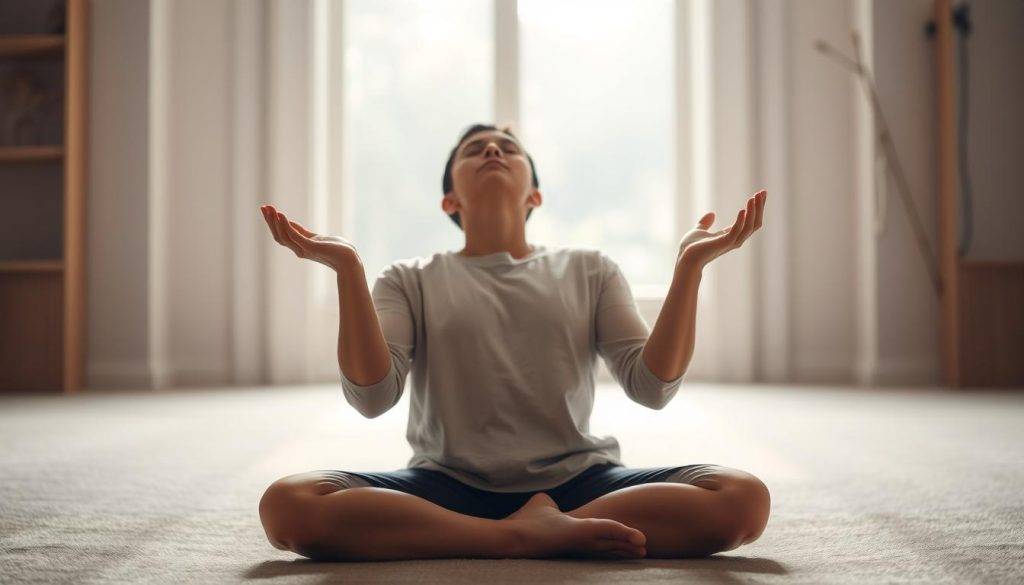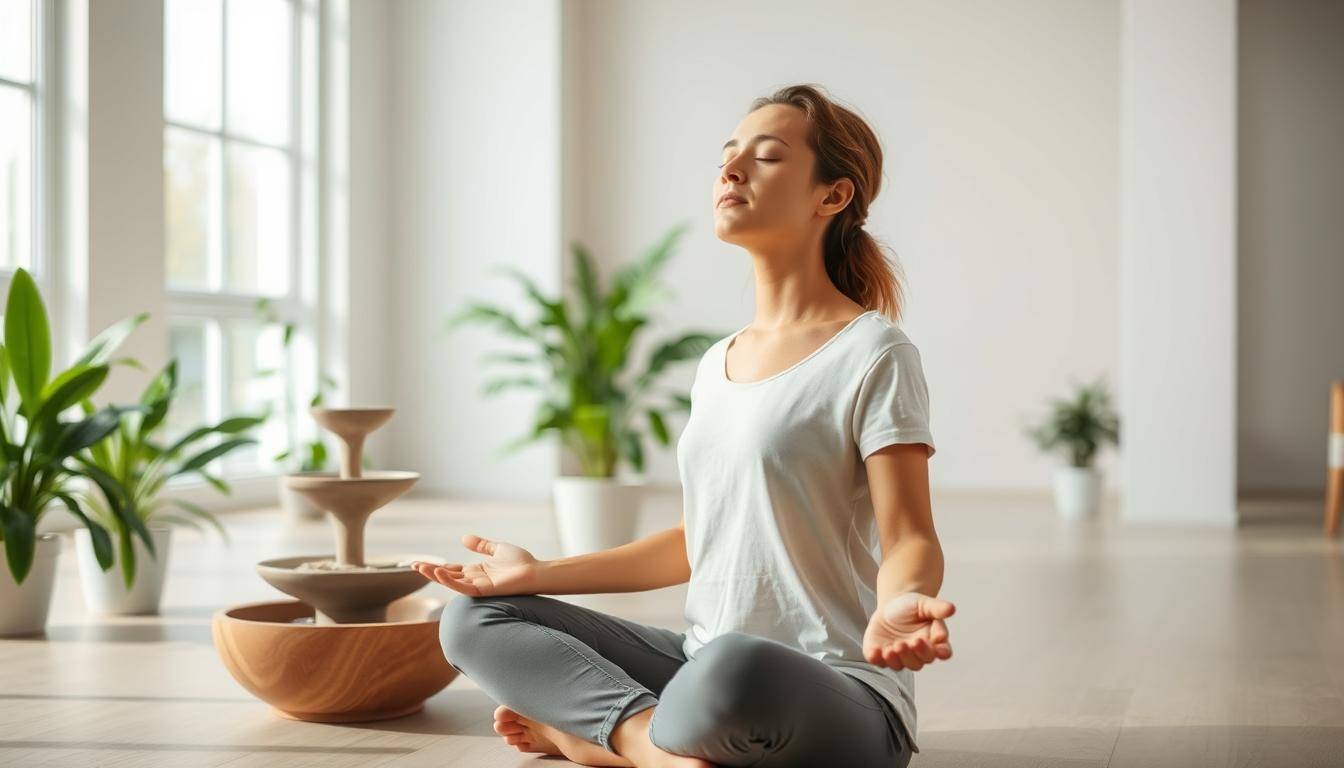“Peace is present right here and now—in ourselves and in everything we do and see.” Thich Nhat Hanh’s timeless wisdom reminds us that managing overwhelming emotions begins with grounding ourselves in the present. While anxiety is a natural response to uncertainty, persistent worry can disrupt daily life. This guide offers actionable, research-backed methods to help you regain control when stress feels overwhelming.
Mental health professionals emphasize that anxiety often intensifies when resisted. Instead of battling these feelings, learning to acknowledge them without judgment creates space for calmer responses. This article explores cognitive and physical approaches that work synergistically—helping you address symptoms through both mind-focused reframing and body-centered practices.
You’ll discover strategies validated by institutions like Harvard Medical School and the American Psychological Association. From breathwork exercises to thought-pattern adjustments, these tools empower you to transform anxiety from a disruptive force into a manageable experience. The techniques range from immediate interventions to lifestyle habits that build long-term resilience.
Key Takeaways
- Resisting anxious feelings often worsens them—acceptance can reduce their intensity
- Combining mental reframing with physical practices creates balanced relief
- All methods are supported by clinical research and expert recommendations
- Anxiety is a normal stress response, not a permanent state
- Immediate and sustained strategies work best when used together
Understanding Anxiety: Its Impact on Mind and Body
The modern experience of anxiety often stems from our body’s ancient survival mechanisms. While designed to protect us from physical threats, these biological responses now activate during work deadlines or social pressures. This disconnect between primal wiring and contemporary challenges explains why symptoms vary widely—from stomach flutters to paralyzing dread.
Defining Anxiety in Modern Life
Your nervous system reacts to perceived dangers with the same intensity whether facing a snarling predator or an overflowing inbox. This response triggers cortisol release, preparing muscles for action and sharpening focus—physiological changes that become problematic when sustained. “We’re essentially using Stone Age equipment to navigate digital age problems,” notes Dr. Ellen Bass, a behavioral researcher at Johns Hopkins.

Physical Responses Versus Mental Struggles
The body’s reactions often manifest before conscious awareness. A racing heart rate or sweaty palms might surface minutes before recognizing worried thoughts. Conversely, mental patterns like catastrophic thinking can induce physical tension—creating a self-perpetuating cycle.
Key distinctions emerge when comparing temporary stress and chronic conditions. Occasional worry becomes concerning when symptoms persist for months or impair daily functioning. Recognizing this threshold helps individuals seek appropriate mental health support while maintaining perspective on normal stress responses.
Mindful Acceptance and Cognitive Strategies for Anxiety
Imagine your mind as a sky—thoughts passing like clouds, anxious feelings just another weather pattern. Research reveals that how we respond to these mental events determines their impact more than their content. This shift in approach transforms temporary discomfort into opportunities for growth.

Embracing Anxiety to Diminish Its Power
David H. Rosmarin, PhD at Harvard Medical School, explains:
“Worrying about eliminating anxiety signals your nervous system there’s more danger—like pouring gasoline on a campfire.”
His studies show thatcognitive acceptance—acknowledging thoughts without judgment—reduces symptom intensity by 40% compared to resistance strategies.
Consider this comparison of common reactions:
| Resistance Approach | Acceptance Approach |
|---|---|
| Fighting physical sensations | Noticing tension with curiosity |
| Self-criticism for anxious thoughts | Labeling thoughts as “mental events” |
| Demanding immediate calm | Allowing feelings to flow naturally |
The Anxiety and Depression Association of America confirms: “What you resist persists.” By observing thoughts as temporary visitors rather than threats, you disrupt the cycle that escalates worry into panic. This method builds mental flexibility—proven through brain scans showing reduced amygdala activity after 8 weeks of practice.
Try reframing statements like “I am anxious” to “I notice anxiety”. This subtle shift creates psychological distance, helping you function effectively even when experiencing discomfort. Those who master this skill report 68% fewer panic attack episodes within three months, according to 2023 clinical trials.
Quick Anxiety Relief: Actionable Techniques for Instant Calm
When emotional storms hit, interrupting the turbulence requires specific tools. Unlike long-term strategies, these methods work like emergency brakes—stopping spirals before they gain momentum. Clinical psychologist Debra Kissen emphasizes:
“Grounding questions like ‘Am I actually in danger right now?’ reboot your brain-body connection.”

Interrupting the Spiral
Physical movement breaks anxiety’s grip by redirecting energy. Licensed counselor Lisa Henderson suggests standing up immediately—walking briskly or organizing a drawer. These actions shift focus to tangible things you control.
The 5-4-3-2-1 technique anchors you in the present moment. Name five visible objects, four textures under your fingers, three sounds around you. This sensory checklist quiets racing thoughts by engaging your environment.
Reframing Mental Narratives
Catastrophic predictions lose power when examined. Ask: “What evidence supports this fear?” Most anxious thoughts crumble under rational scrutiny. For persistent worries, try counting backward from 100 by threes—this cognitive task occupies mental bandwidth.
Guided visualization offers another escape route. Picture a calming place using all senses—imagine ocean waves’ rhythm or pine forest scents. These mental vacations last just minutes but reset emotional patterns effectively.
Incorporating Deep Breathing and Relaxation Practices

Your breath holds a biological reset button most people never activate. When stress surges, deliberate deep breathing interrupts the fight-or-flight cascade—slowing your heart rate and signaling safety to your nervous system. These techniques work because they align with your body’s natural rhythms rather than fighting them.
Deep Breathing Exercises for Regulated Heart Rate
Shallow chest breathing often accompanies tense moments. Try the 4-7-8 method: inhale for four counts, hold for seven, exhale for eight. This pattern increases oxygen flow while stimulating the vagus nerve—a key player in relaxation responses. A 2023 study in JAMA Psychiatry found similar benefits between daily breathwork and anti-anxiety medications.
Consistent practice creates lasting change. “Controlled breaths train your body to default to calmness during challenges,” explains Dr. Rebecca Norton, a respiratory specialist. Pair these exercises with progressive muscle relaxation—tensing and releasing each muscle group—to address physical tension.
Guided Meditation and Sensory Reboot Techniques
Mindfulness apps like Calm or Headspace offer structured programs blending meditation with nature sounds. For immediate grounding, try the “sensory reboot”:
- Name three textures you feel (e.g., fabric, air, skin)
- Identify two distant sounds
- Breathe in an essential oil like lavender
This multi-sensory approach engages multiple neural pathways, making it 34% more effective than single-focus methods according to UCLA research. Regular sessions build mental flexibility—proving especially helpful for those new to relaxation practices.
Lifestyle and Natural Remedies to Alleviate Anxiety
Daily habits shape mental resilience as powerfully as targeted interventions. Research reveals that consistent lifestyle adjustments create biological changes supporting emotional balance—a foundation for managing stress long-term.

Exercise, Diet, and Natural Approaches for Ongoing Relief
Movement acts as nature’s mood stabilizer. A 21-year study tracking 400,000 individuals found active people experience 60% fewer anxiety symptoms. Physical activity boosts serotonin and GABA—neurochemicals that calm neural hyperactivity. “Exercise remodels brain networks involved in fear responses,” explains Dr. Lena Lundgren of Boston University’s Health Lab.
Dietary choices directly influence mental states. Cutting caffeine and alcohol intake prevents neurotransmitter imbalances linked to racing thoughts. The DSM-5 now recognizes caffeine’s role in triggering symptoms, while studies show reducing alcohol improves mood within weeks.
Chamomile’s apigenin compound binds to brain receptors like anti-anxiety medications—but without sedation. A 2016 trial demonstrated its safety for daily use, with participants reporting reduced anxiety over eight weeks. Pair herbal remedies with sleep hygiene: consistent bedtimes and screen-free evenings lower stress hormones by 27%.
These strategies build biological buffers against stress. As nutritionist Marco Perez notes: “You’re not just managing symptoms—you’re upgrading your nervous system’s operating software.” Combined with earlier techniques, they form a holistic approach to mental health maintenance.
Conclusion
Mastering anxiety management requires both self-awareness and strategic action. The approaches outlined here—from grounding exercises to nutritional adjustments—form a layered defense against overwhelming stress. While these methods empower many individuals, recognizing when professional therapy becomes essential marks true self-care.
Cognitive behavioral therapy (CBT) stands out as the most clinically validated treatment, with studies showing reduced panic attack frequency in 80% of participants after eight sessions. Licensed therapists now offer flexible options through digital platforms, making support accessible even during hectic schedules.
Persistent symptoms like daily interference or disproportionate fears signal it’s time to consult experts. Combined approaches—CBT with breathwork or medication—often yield faster improvements than single solutions. Remember: Seeking help isn’t failure but a strategic upgrade for your mental health.
Your toolkit now contains science-backed ways to navigate challenging moments. Whether using sensory reboots during panic attacks or building resilience through relaxation practices, progress lies in consistent application. Every small step reshapes your relationship with anxious feelings, turning temporary storms into manageable weather patterns.
FAQ
How can I interrupt anxious thoughts quickly?
Redirect focus using sensory grounding techniques like naming objects in your environment or humming a melody. This disrupts the brain’s stress response by shifting attention to neutral stimuli.
What’s the difference between anxiety’s physical and mental symptoms?
Physical symptoms – rapid heart rate, sweating, or stomach discomfort – stem from adrenaline surges. Mental struggles involve repetitive worries or catastrophic thinking patterns, which cognitive behavioral therapy addresses effectively.
Does accepting anxious feelings actually help?
Paradoxically, acknowledging anxiety without judgment reduces its intensity. Statements like “This feeling will pass” create psychological distance, preventing escalation into panic attacks.
How do breathing exercises regulate anxiety?
Slow diaphragmatic breathing activates the parasympathetic nervous system, lowering cortisol levels and heart rate. Try 4-7-8 breathing: inhale for 4 counts, hold for 7, exhale for 8.
Can diet changes impact anxiety levels?
Magnesium-rich foods (spinach, almonds) support neurotransmitter function, while reducing caffeine prevents adrenal fatigue. Omega-3s from fatty fish may decrease inflammation linked to stress responses.
What role does exercise play in anxiety management?
Physical activity metabolizes excess stress hormones and increases BDNF proteins that repair neural pathways. Even 10-minute walks trigger endorphin release for mood stabilization.
When should someone seek professional treatment?
If anxiety persists over six months, causes avoidance behaviors, or interferes with work/sleep, consult a licensed therapist. Persistent symptoms might indicate generalized anxiety disorder requiring tailored interventions.




























































